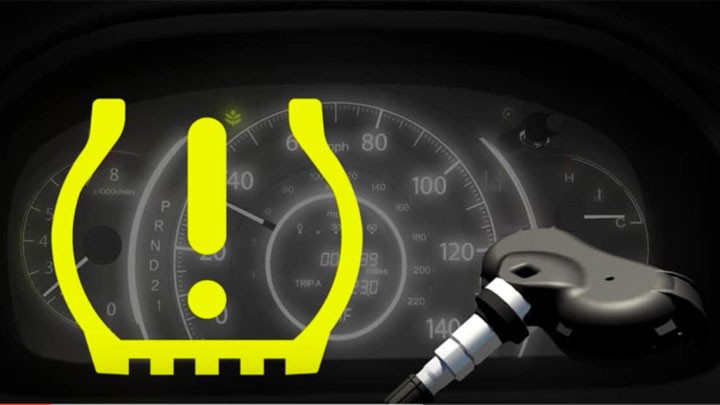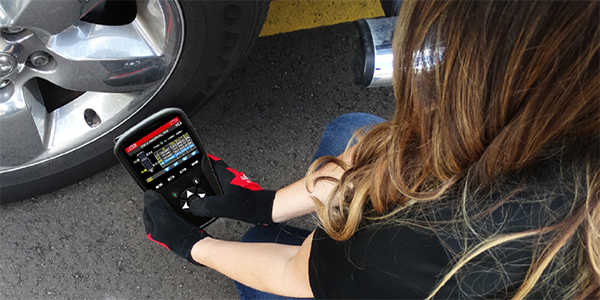Faulty Tire Pressure Sensor II Everything You Want to Know
When you are in a hurry in your car, you see a message "tire pressure sensor fault" or a warning light in the instrument cluster. Do you know what does it mean? I think you don't have a clear idea about it, and that's why you are in my article. But as you have reached here in this article, you don't need to be worried more. I am here to help you. Below I am going to tell you everything about faulty tire pressure sensor.
What is a Tire Pressure Sensor?
A tire pressure sensor is an electronic device that is very small in size. It is made to measure the air pressure inside your vehicle tire which is located in the pressurized pocket made by a wheel and tire. Each tire has a tire pressure sensor. When the tire is low on air, it will alert the driver. This system is known as the TPMS system. It works typically via low-frequency radio waves to the vehicle's onboard computer. From 2007, it has become mandatory on all vehicles in the U.S.
The Types of Tire Pressure Sensors
There are mainly two types of tire pressure sensors. The first one is a valve type. The sensor and the valve stem are one unit. And when the sensor is mounted to the inside of the rim with a metal band, that is called a band sensor.
Though there is a difference in their type, they work the same. When they read lower air pressure than it's supposed to be, they alert the driver through dash light.
How does tire pressure sensor work?
Most of the vehicles manufactured after 2007 have come with this system. It works in two different ways. There are sensors in each tire that sends the information of the current condition of your tire to the TPMS control unit. When there is too high or too low tire pressure, or when the TPMS system can't communicate with the sensors located in the tires, you get a message tire pressure sensor fault on the dashboard.
Some vehicles have no tire pressure sensors. Alternatively, there are ABS sensors that calculate the wheel rotation. If there is low pressure in a tire, it will rotate faster. So, when there is something wrong, the TPMS or ABS system will receive an error code.
What does a tire pressure sensor fault message look like?

If you have a problem with the tire pressure, the sensor will send a message or signal to the vehicle's computer. Then you will see a light on the dashboard. It looks like an exclamation point (!), inside of a "U" shaped symbol. Generally, it is bright yellow. It means your tire pressure is low or it can be flat. The error code can also tell that the tire pressure sensor is defective. Sometimes it can happen because of a faulty TMPS control unit, faulty wiring, or a TPMS reset. You will be able to find the exact problem with an OBD2 Scanner.
Related articles
The symptoms of a tire pressure sensor fault
- warning light
- higher fuel economy
- wear on the tires
Should you drive the vehicle after getting that message?
It depends on the problem. After getting the message, you should check the tire pressure. When it is low, you will not be able to control it as your wish which can be dangerous. If you continue driving the car in low tire pressure, it can cause at least unbalanced tire wear and at most a damaged tire to its structural integrity. In this respect, a flat tire will be damaged the most, and you will require that tire to be replaced very soon.
But it can also happen because of a faulty tire pressure sensor. You will understand it when you confirm that the tire pressure is adequate to run the car. A faulty sensor can't read the actual tire pressure, and you never know the exact condition of the tire. So, you should fix it as early as possible, otherwise, it can be a reason for an unexpected occurrence.
If there is a problem with the TPMS control unit, read it with a scanner. In this respect, you need to use a quality product, because the cheaper scanners can only read the ECU.
How to fix this tire pressure sensor fault code?

At first, you need to check the tire pressure of all tires in the vehicle with a tire pressure gauge. You will do that to make sure that there is no problem with the tire pressure. You will get the correct pressure by checking the tire pressure label. You can find it on the body behind the driver's door or in the repair manual. You will inflate a little more pressure than the label's recommendation if you find the tires in a warm condition. Tire temperature has a great impact on its pressure.
Suppose the tire pressure is okay at 220 kpa according to the label. If the tire pressure drops down the label, the TPMS system will show you an error code. But when it is 220 kpa and hot, you need to inflate a little more than the indication on the label.
Now, you need to reset the system manually. Some cars have come with a reset button. You can reset it through this button. But if there is no button, you can take help from the repair manual to reset the system.
After reset, if you still face any error, you will have to read the TPMS system error codes. The code will tell you either it is the communication error with the tire pressure sensor or the tire pressure sensor is not working anymore. Then fix it with a TPMS activation tool.
Final Words
I have come to the end of my article. Now, I don't want to tell you anything more, because I am told you everything about tire pressure sensor fault. If you read it carefully, then now you have a clear idea about the topic. Below there are also some essential topics to know as a car owner-
Conclusion
When you are in a hurry in your car, you see a message "tire pressure sensor fault" or a warning light in the instrument cluster. Do you know what does it mean? I think you don't have a clear idea about it, and that's why you are in my article. But as you have reached here in this article, you don't need to be worried more. I am here to help you. Below I am going to tell you everything about faulty tire pressure sensor.
What is a Tire Pressure Sensor?
A tire pressure sensor is an electronic device that is very small in size. It is made to measure the air pressure inside your vehicle tire which is located in the pressurized pocket made by a wheel and tire. Each tire has a tire pressure sensor. When the tire is low on air, it will alert the driver. This system is known as the TPMS system. It works typically via low-frequency radio waves to the vehicle's onboard computer. From 2007, it has become mandatory on all vehicles in the U.S.
The Types of Tire Pressure Sensors
There are mainly two types of tire pressure sensors. The first one is a valve type. The sensor and the valve stem are one unit. And when the sensor is mounted to the inside of the rim with a metal band, that is called a band sensor.
Though there is a difference in their type, they work the same. When they read lower air pressure than it's supposed to be, they alert the driver through dash light.
How does tire pressure sensor work?
Most of the vehicles manufactured after 2007 have come with this system. It works in two different ways. There are sensors in each tire that sends the information of the current condition of your tire to the TPMS control unit. When there is too high or too low tire pressure, or when the TPMS system can't communicate with the sensors located in the tires, you get a message tire pressure sensor fault on the dashboard.
Some vehicles have no tire pressure sensors. Alternatively, there are ABS sensors that calculate the wheel rotation. If there is low pressure in a tire, it will rotate faster. So, when there is something wrong, the TPMS or ABS system will receive an error code.
What does a tire pressure sensor fault message look like?

If you have a problem with the tire pressure, the sensor will send a message or signal to the vehicle's computer. Then you will see a light on the dashboard. It looks like an exclamation point (!), inside of a "U" shaped symbol. Generally, it is bright yellow. It means your tire pressure is low or it can be flat. The error code can also tell that the tire pressure sensor is defective. Sometimes it can happen because of a faulty TMPS control unit, faulty wiring, or a TPMS reset. You will be able to find the exact problem with an OBD2 Scanner.
Related articles
The symptoms of a tire pressure sensor fault
- warning light
- higher fuel economy
- wear on the tires
Should you drive the vehicle after getting that message?
It depends on the problem. After getting the message, you should check the tire pressure. When it is low, you will not be able to control it as your wish which can be dangerous. If you continue driving the car in low tire pressure, it can cause at least unbalanced tire wear and at most a damaged tire to its structural integrity. In this respect, a flat tire will be damaged the most, and you will require that tire to be replaced very soon.
But it can also happen because of a faulty tire pressure sensor. You will understand it when you confirm that the tire pressure is adequate to run the car. A faulty sensor can't read the actual tire pressure, and you never know the exact condition of the tire. So, you should fix it as early as possible, otherwise, it can be a reason for an unexpected occurrence.
If there is a problem with the TPMS control unit, read it with a scanner. In this respect, you need to use a quality product, because the cheaper scanners can only read the ECU.
How to fix this tire pressure sensor fault code?

At first, you need to check the tire pressure of all tires in the vehicle with a tire pressure gauge. You will do that to make sure that there is no problem with the tire pressure. You will get the correct pressure by checking the tire pressure label. You can find it on the body behind the driver's door or in the repair manual. You will inflate a little more pressure than the label's recommendation if you find the tires in a warm condition. Tire temperature has a great impact on its pressure.
Suppose the tire pressure is okay at 220 kpa according to the label. If the tire pressure drops down the label, the TPMS system will show you an error code. But when it is 220 kpa and hot, you need to inflate a little more than the indication on the label.
Now, you need to reset the system manually. Some cars have come with a reset button. You can reset it through this button. But if there is no button, you can take help from the repair manual to reset the system.
After reset, if you still face any error, you will have to read the TPMS system error codes. The code will tell you either it is the communication error with the tire pressure sensor or the tire pressure sensor is not working anymore. Then fix it with a TPMS activation tool.
Final Words
I have come to the end of my article. Now, I don't want to tell you anything more, because I am told you everything about tire pressure sensor fault. If you read it carefully, then now you have a clear idea about the topic. Below there are also some essential topics to know as a car owner-



